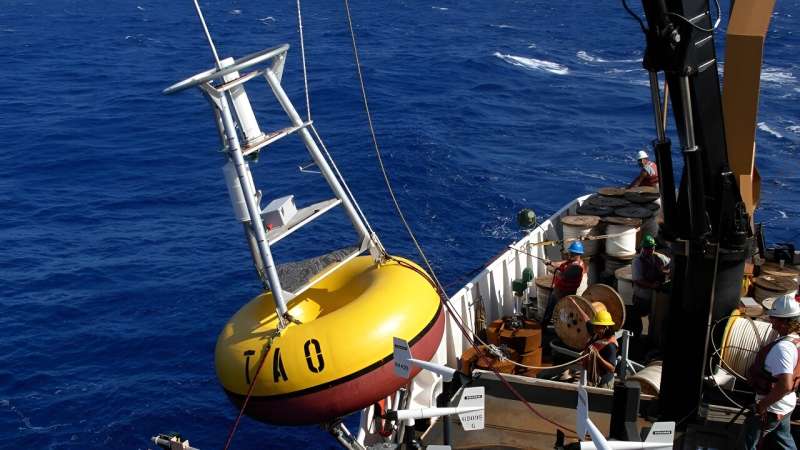This article has been reviewed according to Science X's editorial process and policies. Editors have highlighted the following attributes while ensuring the content's credibility:
fact-checked
peer-reviewed publication
proofread
Bolstered by buoys: Predicting El Niño

The El Niño–Southern Oscillation (ENSO)—the climate phenomenon comprising the warm El Niño, cool La Niña, and neutral climate phases—occurs on a cycle that lasts 2–7 years. When it forms, ENSO drives irregular weather that can spark wildfires, cause drought or flooding, and disrupt agricultural production. Because of its global impacts, accurately forecasting ENSO's extremes is vital for human health and economies.
The Tropical Atmosphere Ocean (TAO) and Triangle Trans-Ocean Buoy Network (TRITON) mooring array straddles the equator across the tropical Pacific Ocean and has been a critical component of the multinational Tropical Pacific Observing System (TPOS) for decades. The TAO/TRITON system collects temperature, salinity, velocity, and surface meteorological data that inform climate predictions.
In response to a loss of monitoring resources, the international Synergistic Observing Network for Ocean Prediction (SynObs) project was formed to determine the best system to monitor and predict ENSO, and a TPOS initiative steering team made plans to reconfigure the array. As part of the effort, Eric Hackert and colleagues investigated the role of TAO/TRITON data in these forecasts. The authors ran two simulations of the 2015 El Niño event, one that incorporated TAO/TRITON data and one that withheld these data. Their results are published in the Journal of Geophysical Research: Oceans.
The results showed that the model assimilating the TAO/TRITON data provided more accurate estimates of temperature and salinity compared with the model without those data. The data notably improved reconstructions in the eastern tropical Pacific—off the coast of South America—where the upwelling of cold water shapes the ENSO climate response. In the same region, the TAO/TRITON model better forecast the increase in sea surface temperature that defines El Niño. Furthermore, data from the mooring array help to reveal the amplitude and timing of Kelvin and Rossby waves—specific kinds of ocean waves that are essential for ENSO cycling.
The results highlight the value of near-equatorial moorings and demonstrate the TAO/TRITON data's impact on ENSO forecasting. The authors note that the results can help inform future network designs as management agencies update observation systems.
More information: Eric Hackert et al, Impact of the TAO/TRITON Array on Reanalyses and Predictions of the 2015 El Niño, Journal of Geophysical Research: Oceans (2023). DOI: 10.1029/2023JC020039
Journal information: Journal of Geophysical Research
Provided by Eos
This story is republished courtesy of Eos, hosted by the American Geophysical Union. Read the original story here.




















